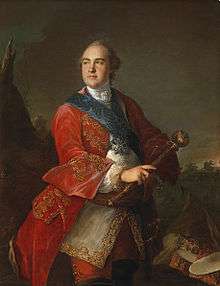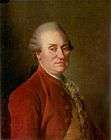Ruthenian nobility
Ruthenian nobility (Polish: szlachta ruska) refers to the nobility of Kievan Rus and Galicia–Volhynia, which found itself in the Grand Duchy of Lithuania, Polish-Lithuanian Commonwealth and later Russian and Austrian Empires, and became increasingly polonized and later russified, while retaining a separate, cultural identity.[1][2][3][4]
Ruthenian nobility, originally characterized as East Slavic language speaking and Orthodox,[1] found itself ruled by the expanding Grand Duchy of Lithuania, where it rose from second class status to equal partners of the Lithuanian nobility.[1] Following the Polish-Lithuanian union of the 14th century, the Ruthenian nobles became increasingly polonized, adopting the Polish language and religion (which increasingly meant converting from the Orthodox faith to Roman Catholicism).[2][3][4] Ruthenian nobility, however, retained a distinct identity within the body of the Polish-Lithuanian szlachta, leading to the Latin expression gente Ruthenus, natione Polonus or gente Rutheni, natione Poloni (translated as "of Polish nationality, but Ruthenian origin",[5] "of Ruthenia race and Polish nation",[6] or in various similar veins), although the extent to which they retained and maintained this separate identity is still debated by scholars, and varied based on time and place.[7][8]
Eventually, following the Union of Lublin in 1569, most of the territories of Ruthenia became part of the Crown of the Polish Kingdom in the Polish-Lithuanian Commonwealth.[3] The transfer of Ruthenian lands from the Grand Duchy to Poland occurred with a strong support of the Ruthenian nobility, who were attracted to the Polish culture and desired the privileges of the Polish nobility.[3] Thus the Ruthenian nobility gravitated from the Lithuanian noble tradition towards the Polish noble one, described by Stone as a change from "wealth without legal rights" to "defined individual and corporate rights".[9] The Lithuanian, Polish and Ruthenian nobility gradually became more and more unified, particularly with regards to their standing as a socio-political class.[6][10] By the 19th and 20th centuries, the Ruthenian nobility became so heavily polonized, that the eventual national resurgence of Belarus and Ukraine was mostly spurred by the growing national consciousness of the new middle class, rather than of the nobility.[2]
Some of the major Ruthenian noble families (all of which became polonized to a significant extent) included the Czartoryski family, Ostrogski family, Sanguszko family, Sapieha, Wiśniowiecki family, Zasławski family and the Zbaraski family.[4]
| Selected Coat-of-arms | ||||||||
|---|---|---|---|---|---|---|---|---|
|
History

Ruthenian nobility were usually of Eastern Slavic origin from incorporated lands of principalities of former Kievan Rus and Kingdom of Galicia–Volhynia into Grand Duchy of Lithuania and Kingdom of Poland, which mostly compromise today's Ukraine and Belarus.
After incorporation of the Baltic nobility of Lithuania Propria actively adopted Ruthenian culture, language and traditions. The Lithuanian higher nobility largely embraced Slavic customs and Orthodox Christianity.Much of the upper class of the Grand Duchy called themselves Lithuanians (Litviny), yet spoke the Ruthenian language (also referred to as Old Ruthenian language)[11][12][13] In the effect of the processes, Lithuanian higher nobility became largely Ruthenian,[14] while the lesser nobility in the ethnic Baltic lands of what is now Republic of Lithuania continued to use native spoken Lithuanian language. The adapted Old Church Slavonic and later the Ruthenian language, acquired a status of a main chancery language in the local matters and relations with other Orthodox principalities as lingua franca, and Latin was used in relations with the Western Europe.[15]
.jpg)
It is estimated that by the 16th century 80% of feudals on Belarusian lands were of Ruthenian ethnicity and 19% of Baltic.[16] No major conflicts between Ruthenian and Baltic szlachta of the Grand Duchy of Lithuania are known. Equality of their rights was also guaranteed by the Lithuanian Statutes of 1529, 1566 and 1588. As time passed, the differences between Lithuanian and Ruthenian factions of the nobility of the inside the Grand Duchy of Lithuania practically disappeared.
Polish-Lithuanian Commonwealth
After Union of Grand Duchy of Lithuania and Kingdom of Poland into Polish-Lithuanian Commonwealth, the non-Polish ethnic groups, especially the Ruthenians and Lithuanians, found themselves under the strong pressure of Polish culture and language.[17][18]
The Polish influence in the regions started from the 1569 Union of Lublin, when many of the Ruthenian territories formerly controlled by the[19][20] Grand Duchy of Lithuania were transferred to the Polish Crown.
In the climate of the colonization of sparsely populated [21] Ruthenian lands by the Polish or Polonized nobility,[22] and peasants from central Poland.
Until the 16th century Old Ruthenian language was used by most of the szlachta of the Grand Duchy of Lithuania, including the Grand Dukes and including the region of Samogitia, both in formal affairs and in private.[23] By the end of the 16th century under number of circumstances like Union of Brest, following prohibition of Orthodox church, increasing number Jesuit Schools, which became one of the main places for szlachta to get education etc. Polish language became more actively used, especially by Magnates while minor szlachta remained Old Ruthenian-speaking.
Since that time the Ruthenian szlachta actively adopted Polish noble customs and traditions, such as Sarmatism. However, despite that the nobility stayed politically loyal to the Grand Duchy of Lithuania and defended it autonomy in disputes with the Polish crown within the Polish-Lithuanian Commonwealth.[14]
Ruthenian nobility in the 17th century
| Selected portraits of Ruthenian nobility | ||||||
|---|---|---|---|---|---|---|
|
Cossack Hetmanate
Following the Pereyaslav Treaty on Left-bank Ukraine was created Cossack Hetmanate. The ruling class in the state became Cossacks. Despite the fact that large number Cossacks didn't have official (granted or confirmed by King and Sejm) noble background, they tended to identify themselves as szlachta and considered those Cossacks who did, as equal. This could be seen in the way of life, art, clothes etc. Following the end of Civil War large number of Ruthenian, Polish (e.g. Zavadovsky, Dunin-Borkovsky, Modzalevsky), Lithuanian (e.g. Narbut, Zabily, Hudovych), Tatar (e.g. Kochubey), Serbian (e.g. Myloradovych), Greek (e.g. Kapnist) etc. noble families moved to Hetmanate. Via intermarriage between Cossacks, Ruthenian and other nobilities, and by nobilitation by reaching high positions in both Hetmanate state and Russia, Cossacks formed Cossack nobility, also known as Cossack Starshyna. Cossack nobility played large role in history of both Ukraine and Russia. By the end of the 18th and beginning of the 19th century they became part of Russian nobility.
| Selected portraits of Cossack nobility | ||||||
|---|---|---|---|---|---|---|
|
Russian Empire
Ruthenian nobility of modern Ukraine in Russian Empire
Ever since the end of the 16th century Ruthenian nobility moved to Russia, because in Polish-Lithuanian Commonwealth they were suppressed by Catholic Polish szlachta and were unable because of that reach high social and political status. After Khmelnytsky Uprising and Pereyaslav Treaty was signed, large number of Ruthenian nobility and Cossacks became citizens of Hetmanate state, which was self-governed but was part Tsardom of Russia. Following merge of Cossacks and Ruthenian nobility into Cossack Nobility, a lot of them sought to receive larger political, social and military status in Russia. From the beginning of the 18th century and until the beginning of the 19th century they played large role in Tsardom of Russia, and then Russian Empire. Families like Rozumovsky and Bezborodko became one of the wealthiest families of Empire.
| Selected portraits of members of Cossack nobility in Russian Empire | ||||||||
|---|---|---|---|---|---|---|---|---|
|
By the end of 18th and the beginning of the 19th century the Hetmanate state despite the Pereyaslav Treaty was abolished by Catherine II. Some Cossacks were forced to move to region of Kuban, where they formed Kuban Cossacks, while most of Cossacks stayed. Most of those who were of nobility descent, reached needed rank of Table of Ranks or was nobilitised by Russian Emperors became part of Russian Dvoryanstvo. Those who were unable to confirm at the moment, were allowed to do it later. After the partitions of Poland, Ruthenian nobility from Ukrainian and other lands of former Polish-Lithuanian Commonwealth were also incorporated into dvoryanstvo. The same way that the Ruthenian nobility had been incorporated in Polish nobility, high nobility of Ruthenian and Cossack descent more and more associated themselves with Russian nation, rather than Rusyn (Ruthenian, Cossack, Ukrainian) nation. Because most of education was primarily taught in Russian and French, and soon Ruthenian nobility started speaking Russian instead of Rusyn language. Through intermarriages and service Ruthenian nobility became large donor for Russian nation. People like Peter Tchaikovsky, Mykhaylo Hohol, Fedor Dostoyevsky, Ivan Paskevych, Mykhaylo Ostrohradsky were great contributors of Russian cultural, scientific and political life.
Ruthenian nobility of modern Belarus in Russian Empire
In the late 18th and 19th centuries Belarusian szlachta were active participants of anti-Russian uprisings on the territory of the former Polish-Lithuanian Commonwealth. Tadeusz Kościuszko (Tadevush Kastsyushka), a nobleman from what is now Belarus, was leader of the Kościuszko Uprising in 1793. Kastus Kalinouski was the leader of January Uprising on the territory of the former Grand Duchy of Lithuania.
By the 19th century polonization of the szlachta on one hand and russification and violent introduction of Russian Orthodoxy to the peasantry on the other hand led to a situation where the social barrier between aristocracy and peasantry on Belarusian lands became in many aspects an ethnic barrier.[24] In the 19th century, the era of nationalism, local intellectuals of peasant origin and some szlachta people like Francišak Bahuševič and Vintsent Dunin-Martsinkyevich contributed to the forming of modern-day Belarusians as a new nation of Slavonic-speaking inhabitants of the former Grand Duchy of Lithuania and basing on the historical and legacy of the Grand Duchy of Lithuania and previous Ruthenian kingdoms of Polatsk and Turau. At the same time Baltic-speakers of the lands of modern Republic of Lithuania formed into modern-day Lithuanians and the historical unity of Ruthenians and Lithuanians fell apart.
At the beginning of the 20th century the Belarusian nobility has been primarily politically active in the Krajowcy political movement. Still, some of them, like Raman Skirmunt or Maria Magdalena Radziwiłł, have been sympathetic with the Belarusian national movement and have supported the creation of an independent Belarusian Democratic Republic in 1918.
After the October Revolution the Belarusian nobility was severely hit by Bolshevist terror. East Belarus faced Soviet terror already since the early 1920s, while most noble people living in West Belarus were repressed only upon the territory's annexation by the USSR in 1939. Belarusian historians speak of a genocide of the Belarusian gentry carried out by the Bolsheviks[16]
However, by the beginning of the 20th century many minor nobles in Belarus were hardly distinguishable from usual peasants, only top aristocracy faced repressions because of their noble origin.
Austrian Empire
Ruthenian nobility today
Upon Belarus regaining independence in 1991, remaining descendants of noble families in Belarus have formed certain organizations, particularly the Union of Belarusian Noble People (Згуртаванне беларускай шляхты). There is, however, a split between the noble people identifying themselves rather with the Polish-Lithuanian szlachta and the Russian dvoryanstvo.
Naming
Initially, the Ruthenian noble people were called Boyars (Ukrainian: бояри; lang-be, translit. баяры) (on the territory of what is now Republic of Lithuania the word bajorai was used).
After passing of the Horodło privileges along with the word bajary the term bajary-szlachta (баяры-шляхта) or simply szlachta (шляхта) was used in documentation of the Grand Duchy of Lithuania that was predominantly written in Old Belarusian language. In the 15th and 16th centuries nobility in Polesia or Podlacha was also often called ziamianie (зямяне). Since the second quarter of the 16th century the word szlachta (шляхта) became the dominant Belarusian term for noble people.
Religion
By the 14th century the majority of the Belarusian nobility, both Baltic and Ruthenian, were Eastern Orthodox. After the Christianization of pagan Baltic tribes of what is now Republic of Lithuania in 1387 more and more noble people started converting to Roman Catholicism which became the dominant religion among aristocracy.
In the 16th century a large part of Belarusian nobility, both Catholic and Orthodox, converted to Calvinism and other Protestant churches following the example of the Radziwills. However, under the influence of counter-reformation in the late 16th century and early 17th century most of them converted to Roman Catholicism. By the annexation of modern Belarusian lands by the Russian Empire in the end of the 18th century the Belarusian gentry was predominantly Roman Catholic while the rest of the population was mainly Eastern Catholic with a small Eastern Orthodox minority living in the east of modern Belarus. Still, there was also Eastern Orthodox szlachta in the surroundings of Pinsk, Davyd-Haradok, Slutsk and Mahiliou as well as calvinist szlachta.
Heraldry
See Polish heraldry
Belarusian aristocrats had their family symbols already in the 14th century. One of the privileges introduced to the gentry by the Union of Horodlo was the usage of Polish (sometimes modified) coats of arms.
There are about 5 thousands coats of arms of Polish, Belarusian, Lithuanian and Ukrainian szlachta.
Notable Ruthenian noble families
See also
External links
- Association of the Belarusian nobility
- History and genealogy of the noble Konstantynowicz family from Belarus and Lithuania
References
- 1 2 3 Daniel Z Stone (2001). The Polish-Lithuanian State: 1386-1795. University of Washington Press. pp. 12–13. ISBN 978-0-295-98093-5. Retrieved 19 November 2012.
- 1 2 3 Anna Reid (1 June 2000). Borderland: A Journey Through the History of Ukraine. Basic Books. pp. 29–30. ISBN 978-0-8133-3792-0. Retrieved 19 November 2012.
- 1 2 3 4 Professor Paul Robert Magocsi (11 May 2010). History of Ukraine: The Land and Its Peoples. University of Toronto Press. p. 157. ISBN 978-1-4426-1021-7. Retrieved 19 November 2012.
- 1 2 3 Daniel Z Stone (2001). The Polish-Lithuanian State: 1386-1795. University of Washington Press. pp. 45–46. ISBN 978-0-295-98093-5. Retrieved 20 November 2012.
- ↑ Rosita Rindler Schjerve (2003). Diglossia and Power: Language Policies and Practice in the 19th Century Habsburg Empire. Walter de Gruyter. p. 144. ISBN 978-3-11-017654-4. Retrieved 19 November 2012.
- 1 2 Piotr Stefan Wandycz (1974). The Lands of Partitioned Poland: 1795-1918. University of Washington Press. p. 5. ISBN 978-0-295-95358-8. Retrieved 20 November 2012.
- ↑ Ilya Prizel (13 August 1998). National Identity and Foreign Policy: Nationalism and Leadership in Poland, Russia and Ukraine. Cambridge University Press. p. 300. ISBN 978-0-521-57697-0. Retrieved 19 November 2012.
- ↑ Daniel Z Stone (2001). The Polish-Lithuanian State: 1386-1795. University of Washington Press. p. 25. ISBN 978-0-295-98093-5. Retrieved 20 November 2012.
- ↑ Daniel Z Stone (2001). The Polish-Lithuanian State: 1386-1795. University of Washington Press. p. 225. ISBN 978-0-295-98093-5. Retrieved 20 November 2012.
- ↑ Jörn Leonhard; Christian Wieland (23 June 2011). What Makes the Nobility Noble?: Comparative Perspectives from the Sixteenth to the Twentieth Century. Vandenhoeck & Ruprecht. p. 152. ISBN 978-3-525-31041-0. Retrieved 20 November 2012.
- ↑ (English) Jerzy Lukowski; Hubert Zawadzki (2001). A Concise History of Poland. Cambridge: Cambridge University Press. pp. 33–45. ISBN 0-521-55917-0.
- ↑ (English) Serhii Plokhy (2006). The Origins of the Slavic Nations: Premodern Identities in Russia, Ukraine, and Belarus. Cambridge: Cambridge University Press. pp. 109–111. ISBN 0-521-86403-8.
- ↑ "The son of Gediminas, the Grand Prince Olgerd [(Algirdas)] expanded the Ruthenian lands he inherited from his father: he attached the Polish lands to his state expelling the Tatars out. The Ruthenian lands under his sovereignty were divided between princes. However, Olgerd, the person of a strong character, controlled them. In Kyiv, he installed his son, Vladimir, who started the new line of Kiev princes that reigned there for over a century and called commonly the Olelkoviches, from Olelko, Aleksandr Vladimirovich, the grand-son of Olgerd. Olgerd himself, married twice the Ruthenian princesses, allowed his sons to baptize into Ruthenian religion and, as the Ruthenian Chronicles speak, had himself baptized and died as a monk. As such, the princes that replaced the St. Vladimir's [Rurikid] line in Ruthenia, became as Ruthenian by religion and by the ethnicity they adopted, as the princes of the line that preceded them. The Lithuanian state was called Lithuania, but of course it was purely Ruthenian and would have remained Ruthenian if only the successor of Olgerd in the Great Princehood, the Jagiello wouldn't have married in 1386 to the Polish queen Jadwiga"
(Russian) Nikolay Kostomarov, Russian History in Biographies of its main figures, section Knyaz Kostantin Konstantinovich Ostrozhsky (Konstanty Wasyl Ostrogski) - 1 2 "Within the [Lithuanian] Grand Duchy, the Ruthenian lands initially retained considerable autonomy. The pagan Lithuanians themselves were increasingly converting to Orthodoxy and assimilating into Ruthenian culture. The grand duchy's administrative practices and legal system drew heavily on Ruthenian customs, and Ruthenian (Old Belarusian) became the official state language. Direct Polish rule in Ukraine since the 1340s and for two centuries thereafter was limited to Galicia. There, changes in such areas as administration, law, and land tenure proceeded more rapidly than in Ukrainian territories under Lithuania. However, Lithuania itself was soon drawn into the orbit of Poland."
from Ukraine. (2006). In Encyclopædia Britannica. - ↑ (Lithuanian) Zigmas Zinkevičius The Problem of a Slavonic Language as a Chancery Language in the Grand Duchy of Lithuania
- 1 2 Анатоль Грыцкевіч. Беларуская шляхта // Часопіс "Спадчына", 1993 г.
- ↑ Nataliia Polonska-Vasylenko, History of Ukraine, "Lybid", (1993), ISBN 5-325-00425-5, v.I, Section: "Ukraine under Poland"
- ↑ Natalia Iakovenko, Narys istorii Ukrainy s zaidavnishyh chasic do kincia XVIII stolittia, Kiev, 1997, Section: 'Ukraine-Rus, the "odd man out" in Rzeczpospolita Obojga Narodow
- ↑ "Within the [Lithuanian] grand duchy, the Ruthenian lands initially retained considerable autonomy. The pagan Lithuanians themselves were increasingly converting to Orthodoxy and assimilating into Ruthenian culture. The grand duchy's administrative practices and legal system drew heavily on Slavic customs, and Ruthenian became the official state language. Direct Polish rule in Ukraine since the 1340s and for two centuries thereafter was limited to Galicia. There, changes in such areas as administration, law, and land tenure proceeded more rapidly than in Ukrainian territories under Lithuania. However, Lithuania itself was soon drawn into the orbit of Poland." from Ukraine. (2006). In Encyclopædia Britannica. Retrieved June 3, 2006, from Encyclopædia Britannica Premium Service:
- ↑ Polonska-Vasylenko, Section: Evolution of Ukrainian lands in the 15th and 16th centuries
- ↑ Piotr S. Wandycz, United States and Poland, Harvard University Press, 1980, p. 16
- ↑ "Transferred as a result of the Union of Lublin from the grand duchy of Lithuania to the more ethnically homogeneous Crown, Ukraine was “colonized” by both Polish and Ukrainian great nobles. Most of the latter gradually abandoned Orthodoxy to become Roman Catholic and Polish. These 'little kings' of Ukraine controlled hundreds of thousands of 'subjects'" from Wladyslaw IV Vasa in "Poland, history of". (2006). In Encyclopædia Britannica. Retrieved June 3, 2006, from Encyclopædia Britannica Premium Service:
- ↑ Анатоль Грыцкевіч. Беларуская шляхта // Часопіс "Спадчына", 1993 г.
- ↑ http://arche.by/by/15/40/692/
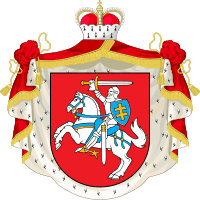
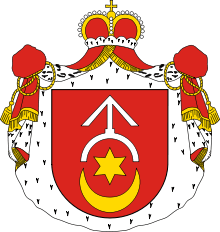
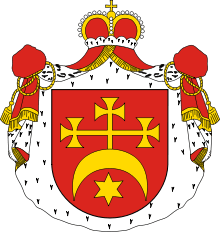
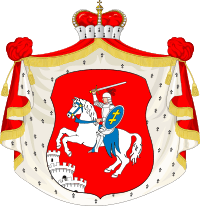

.jpg)



